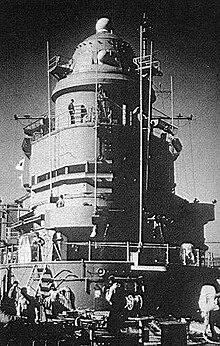
Radar is a detection system that uses radio waves to determine the distance (ranging), angle, or velocity of objects. It can be used to detect aircraft, ships, spacecraft, guided missiles, motor vehicles, weather formations, and terrain. A radar system consists of a transmitter producing electromagnetic waves in the radio or microwaves domain, a transmitting antenna, a receiving antenna and a receiver and processor to determine properties of the object(s). Radio waves from the transmitter reflect off the object and return to the receiver, giving information about the object's location and speed.
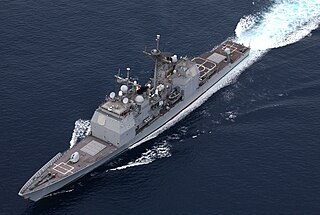
The Aegis Combat System is an American integrated naval weapons system developed by the Missile and Surface Radar Division of RCA, and now produced by Lockheed Martin. It uses powerful computer and radar technology to track and guide weapons to destroy enemy targets.
Semi-active radar homing (SARH) is a common type of missile guidance system, perhaps the most common type for longer-range air-to-air and surface-to-air missile systems. The name refers to the fact that the missile itself is only a passive detector of a radar signal—provided by an external ("offboard") source—as it reflects off the target. Semi-active missile systems use bistatic continuous-wave radar.

Direction finding (DF), or radio direction finding (RDF), is – in accordance with International Telecommunication Union (ITU) – defined as radio location that uses the reception of radio waves to determine the direction in which a radio station or an object is located. This can refer to radio or other forms of wireless communication, including radar signals detection and monitoring (ELINT/ESM). By combining the direction information from two or more suitably spaced receivers, the source of a transmission may be located via triangulation. Radio direction finding is used in the navigation of ships and aircraft, to locate emergency transmitters for search and rescue, for tracking wildlife, and to locate illegal or interfering transmitters. RDF was important in combating German threats during both the World War II Battle of Britain and the long running Battle of the Atlantic. In the former, the Air Ministry also used RDF to locate its own fighter groups and vector them to detected German raids.

An active electronically scanned array (AESA) is a type of phased array antenna, which is a computer-controlled array antenna in which the beam of radio waves can be electronically steered to point in different directions without moving the antenna. In the AESA, each antenna element is connected to a small solid-state transmit/receive module (TRM) under the control of a computer, which performs the functions of a transmitter and/or receiver for the antenna. This contrasts with a passive electronically scanned array (PESA), in which all the antenna elements are connected to a single transmitter and/or receiver through phase shifters under the control of the computer. AESA's main use is in radar, and these are known as active phased array radar (APAR).
Track-via-missile or TVM refers to a missile guidance technique which combines features of semi-active radar homing (SARH) and radio command guidance. This avoids the problems with terminal accuracy normally seen by command guided missiles, especially at long range. It has been used on a number of long-range surface-to-air missiles (SAMs) including the MIM-104 Patriot.
A low-probability-of-intercept radar (LPIR) is a radar employing measures to avoid detection by passive radar detection equipment while it is searching for a target or engaged in target tracking. This characteristic is desirable in a radar because it allows finding and tracking an opponent without alerting them to the radar's presence. This also protects the radar installation from anti-radiation missiles (ARM).
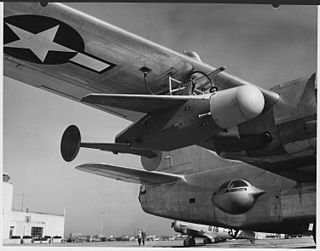
Active radar homing (ARH) is a missile guidance method in which a missile contains a radar transceiver and the electronics necessary for it to find and track its target autonomously. NATO brevity code for an air-to-air active radar homing missile launch is fox three.

A fire-control radar (FCR) is a radar that is designed specifically to provide information to a fire-control system in order to direct weapons such that they hit a target. They are sometimes known as targeting radars, or in the UK, gun-laying radars. If the radar is used to guide a missile, it is often known as an target illuminator or illuminator radar.

The Bendix RIM-8 Talos was a long-range naval surface-to-air missile, and was among the earliest surface-to-air missiles to equip United States Navy ships. The Talos used radar beam riding for guidance to the vicinity of its target, and semiactive radar homing (SARH) for terminal guidance. The array of four antenna which surround the nose are SARH receivers which functioned as a continuous wave interferometer. Initial thrust was provided by a solid rocket booster for launch and a Bendix ramjet for flight to the target with the warhead serving as the ramjet's compressor.

The Tartar Guided Missile Fire Control System is an air defense system developed by the United States Navy to defend warships from air attack. Since its introduction the system has been improved and sold to several United States allies.
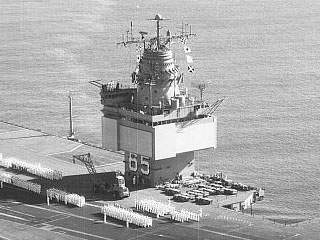
The Hughes SCANFAR was the first phased array radar system to be deployed by the US Navy, installed on the USS Long Beach (CGN-9) and USS Enterprise (CVN-65). It consisted of two search radars, the AN/SPS-32 and the AN/SPS-33. In 1982, the system was removed from Long Beach, and was replaced by the AN/SPS-48 during a comprehensive overhaul. Aboard the Long Beach, the system used AN/SPG-55 radars for missile guidance.

A passive electronically scanned array (PESA), also known as passive phased array, is an antenna in which the beam of radio waves can be electronically steered to point in different directions, in which all the antenna elements are connected to a single transmitter and/or receiver. The largest use of phased arrays is in radars. Most phased array radars in the world are PESA. The civilian microwave landing system uses PESA transmit-only arrays.

The Sky Bow, or Tien Kung, are a series of surface-to-air anti-ballistic missile and anti-aircraft defense systems developed by Taiwan. The TK-2 and TK-3 are in service with the Military of the Republic of China.
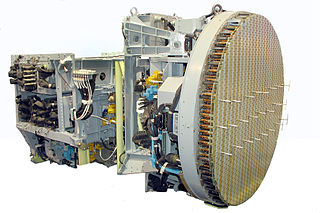
The Bars (Leopard) is a family of Russian all-weather multimode airborne radars developed by the Tikhomirov Scientific Research Institute of Instrument Design for multi-role combat aircraft such as the Su-27 and the MiG-29.
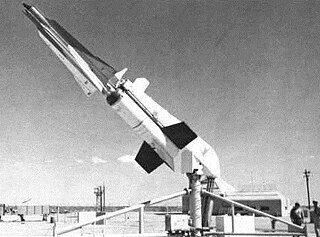
Typhon was a missile system developed by the United States Navy in the late 1950s, intended to serve as an integrated air-defense system for Navy fleets. Consisting of the SAM-N-8 Typhon LR, later designated RIM-50A, and the SAM-N-9 Typhon MR, later RIM-55A, paired with the AN/SPG-59 radar system, the cost and expense of the Typhon system led to it being cancelled in favor of the Standard Missile program.
The track while scan (TWS) is a mode of radar operation in which the radar allocates part of its power to tracking the target or targets while part of its power is allocated to scanning, unlike the straight tracking mode, when the radar directs all its power to tracking the acquired targets. In the TWS mode the radar has a possibility to acquire additional targets as well as providing an overall view of the airspace and helping maintain better situational awareness.

Irbis-E is a Russian multi-mode, hybrid passive electronically scanned array radar system developed by Tikhomirov NIIP for the Su-35 multi-purpose fighter aircraft. NIIP developed the Irbis-E radar from the N011M Bars radar system used on Sukhoi SU-30MKI aircraft.

The AN/SPY-1 is a United States Navy 3D radar system manufactured by Lockheed Martin. The array is a passive electronically scanned system and is a key component of the Aegis Combat System. The system is computer controlled, using four complementary antennas to provide 360 degree coverage. The system was first installed in 1973 on USS Norton Sound and entered active service in 1983 as the SPY-1A on USS Ticonderoga. The -1A was installed on ships up to CG-58, with the -1B upgrade first installed on USS Princeton in 1986. The upgraded -1B(V) was retrofitted to existing ships from CG-59 up to the last, USS Port Royal.

The AN/SPG-60 is a United States tracking radar that is part of the MK-86 Gun Fire Control System (GFCS). It is used for air tracking and on some MK-86 configurations it is also used for illumination for RIM-24 Tartar and RIM-66 Standard missiles. Though the radar is primarily an air tracking radar, the SPG-60 radar can be used for surface tracking. With the boresight mounted camera, the radar could also be used as a sight for optical tracking, optical engagement and damage assessment.
